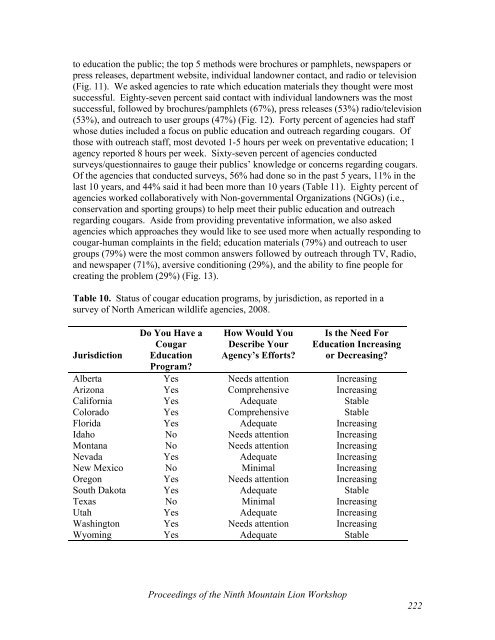Proceedings of the Ninth Mountain Lion Workshop - Carnivore ...
Proceedings of the Ninth Mountain Lion Workshop - Carnivore ...
Proceedings of the Ninth Mountain Lion Workshop - Carnivore ...
Create successful ePaper yourself
Turn your PDF publications into a flip-book with our unique Google optimized e-Paper software.
to education <strong>the</strong> public; <strong>the</strong> top 5 methods were brochures or pamphlets, newspapers or<br />
press releases, department website, individual landowner contact, and radio or television<br />
(Fig. 11). We asked agencies to rate which education materials <strong>the</strong>y thought were most<br />
successful. Eighty-seven percent said contact with individual landowners was <strong>the</strong> most<br />
successful, followed by brochures/pamphlets (67%), press releases (53%) radio/television<br />
(53%), and outreach to user groups (47%) (Fig. 12). Forty percent <strong>of</strong> agencies had staff<br />
whose duties included a focus on public education and outreach regarding cougars. Of<br />
those with outreach staff, most devoted 1-5 hours per week on preventative education; 1<br />
agency reported 8 hours per week. Sixty-seven percent <strong>of</strong> agencies conducted<br />
surveys/questionnaires to gauge <strong>the</strong>ir publics’ knowledge or concerns regarding cougars.<br />
Of <strong>the</strong> agencies that conducted surveys, 56% had done so in <strong>the</strong> past 5 years, 11% in <strong>the</strong><br />
last 10 years, and 44% said it had been more than 10 years (Table 11). Eighty percent <strong>of</strong><br />
agencies worked collaboratively with Non-governmental Organizations (NGOs) (i.e.,<br />
conservation and sporting groups) to help meet <strong>the</strong>ir public education and outreach<br />
regarding cougars. Aside from providing preventative information, we also asked<br />
agencies which approaches <strong>the</strong>y would like to see used more when actually responding to<br />
cougar-human complaints in <strong>the</strong> field; education materials (79%) and outreach to user<br />
groups (79%) were <strong>the</strong> most common answers followed by outreach through TV, Radio,<br />
and newspaper (71%), aversive conditioning (29%), and <strong>the</strong> ability to fine people for<br />
creating <strong>the</strong> problem (29%) (Fig. 13).<br />
Table 10. Status <strong>of</strong> cougar education programs, by jurisdiction, as reported in a<br />
survey <strong>of</strong> North American wildlife agencies, 2008.<br />
Jurisdiction<br />
Do You Have a<br />
Cougar<br />
Education<br />
Program?<br />
How Would You<br />
Describe Your<br />
Agency’s Efforts?<br />
<strong>Proceedings</strong> <strong>of</strong> <strong>the</strong> <strong>Ninth</strong> <strong>Mountain</strong> <strong>Lion</strong> <strong>Workshop</strong><br />
Is <strong>the</strong> Need For<br />
Education Increasing<br />
or Decreasing?<br />
Alberta Yes Needs attention Increasing<br />
Arizona Yes Comprehensive Increasing<br />
California Yes Adequate Stable<br />
Colorado Yes Comprehensive Stable<br />
Florida Yes Adequate Increasing<br />
Idaho No Needs attention Increasing<br />
Montana No Needs attention Increasing<br />
Nevada Yes Adequate Increasing<br />
New Mexico No Minimal Increasing<br />
Oregon Yes Needs attention Increasing<br />
South Dakota Yes Adequate Stable<br />
Texas No Minimal Increasing<br />
Utah Yes Adequate Increasing<br />
Washington Yes Needs attention Increasing<br />
Wyoming Yes Adequate Stable<br />
222
















